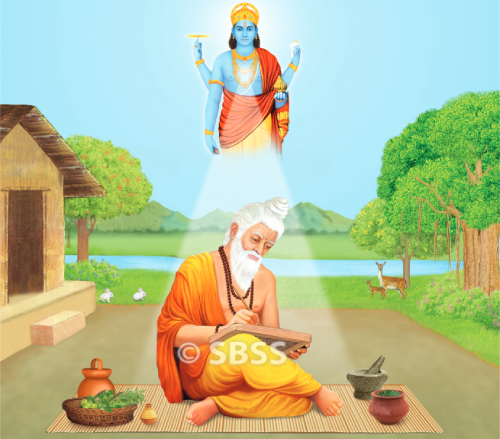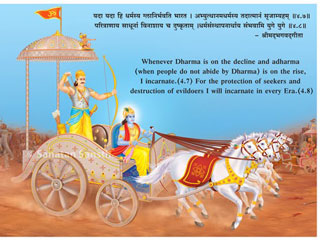Ayurveda for a healthy life ! – 25/2024 (on 1.04.2024)
Part 1 article link : https://sanatanprabhat.org/english/96396.html
 18. Psychological factors : Increased raja and tama qualities of mind give rise to personality disorders. Getting angry and jealous can also lead to congenital anomalies.
18. Psychological factors : Increased raja and tama qualities of mind give rise to personality disorders. Getting angry and jealous can also lead to congenital anomalies.
19. Addiction : Drinking alcohol in excess and smoking heavily during pregnancy can have adverse effects on the foetus. It can lead to congenital anomalies in the foetus.
2. Manifestations
Damage to the foetus and to the mother is indicated if the pregnant woman develops following signs and symptoms.
1. Develops fever, weakness and pallor.
2. Eats in excess and continues to eat till she faints.
3. Develops prominent eyes, cold limbs and ears and knotted hair.
4. Foetus that lies entirely above the umbilicus.
5. Develops arthritis and septic foci in the body and finds difficulty in walking.
6. Woman is worried too much or suffers from sorrow.
7. Develops cyanosis and generalised oedema.
8. Develops backache, thirst, breathlessness and unconsciousness.
9. Develops pain in the waist and vagina, foul-smelling breath, delirium and unconsciousness.
10. Develops nystagmus, stiff nose and smells like that of bird.
11. Wears red dress, red garlands, laughs in sleep and walks towards a cemetry.
12. Dreams of riding on an ass, pig, buffalo, dog or camel.
In these cases it is better to induce abortion or miscarriage or remove the foetus by surgical means and save the life of the mother.
Apart from the various congenital anomalies mentioned earlier, congenital anomalies of sexual organs are also described in Ayurvedic texts. They are –
1. Dwireta : When the foetus that is child manifests both the male and female genital organs that is true hermaphrodite.
2. Ranth or varta : Defect in the genes of the genital organs in the female. Depending on the severity, she may be sterile, have abortion or have none of the qualities of a female.
3. Truna putrika or Truna pulika or Trunamukha : Defect in the genes of the genital organs in the male. Depending on the severity of the defect, he may be sterile or may not have any quality of the male.
4. Nara Shandha : Such a male person looks like and behaves like a female. Such a person is born, if during intercourse father lies in supine and mother takes active part in the intercourse. The sperms are absent.
5. Narishandha : Such a female behaves like a male and enjoys sexual union with another female, ovaries are absent.
6. Anasthi Vatika Shandha : Undescended testes or absence of testes, both of which lead to sterility.
7. Pavanendriya : Here vata destroys the seminal vesicles in the male. Hence he is a sterile person though potent.
3. Prevention
It is important to avoid aetiological factors of hereditary and congenital diseases. The natural desires and cravings of the pregnant women arise from the tissue demand of the foetus and mother. The desire to eat soil is seen in pregnant women, who has an iron deficiency anaemia and this desire represents nature’s attempt to get the iron from soil. It is better to give a particular item which the pregnant women longs for, unless it is dangerous to the foetus. In such a case innocuous item resembling the item craved for should be given in a disguised form. If cravings of the pregnant women are not fulfilled, it often leads to vataprakopa and the foetus may become deformed, deaf, dumb and may develop paralysis.
To prevent congenital anomalies, the pregnant women should avoid the following –
1. Unhappy state of mind or getting upset if the desires are not fulfilled.
2. Anything that might injure her sense or motor organs.
3. Anything that experienced women and physicians declare as harmful.
4. Wearing red clothes.
5. Taking intoxicating wines.
6. Travelling in a carriage.
7. Violent movements.
8. Heavy, hot and pungent food items.
9. Anything to which the pregnant women is not habituated.
10. Inadequate or unbalanced diet, which would affect the nutrition.
It is important to avoid aetiological factors of hereditary diseases and congenital anomalies. Atharvaveda mentions the use of Bhagavati that is Laghushatavari, Aparajita or Vishnukranta and Taraka that is Indravaruni by expectant parents and pregnant women for the prevention of hereditary diseases. For the prevention of congenital heart disease, the pregnant woman should take Mrugshrungabhasma.
The monthly regime of diet and medicines to be followed by a pregnant woman as given in the chapter 19 of Balveda are also worth trying. It is worhwhile trying certain religious rites like Putreshti Yajna as prescribed by the scriptures.
To avoid congenital deformities, sperm of the man and ovum of the woman need to be pure. ‘Vajikaran Chikitsa’ (Aphrodisiac treatment), a separate branch of Ayurveda, deals with the prevention of congenital anomalies by eliminating blemish in the sperm and ovum.
Vegavarodha (Suppression of natural urges)
The concept of ‘veg’ (Urge) is a characteristic of Ayurveda. These urges are considered very important in Ayurveda and are of two types, namely urges that can be resisted and those that should not be resisted. The urges that should not be resisted are mainly physical and are described in detail later in the chapter. To understand the pathogenesis of a disease, an Ayurvedic physician needs to rule out whether the patient has resisted some urges.
For biological existence and optimum functioning, every individual requires a continuous supply of food, water and air. He must excrete the waste products which are being continuously formed as a result of metabolic activities. He must take rest intermittently to replenish the loss incurred during activity. Desires or urges to fulfil these biological needs are naturally present in every individual in the form of hunger, thirst, micturition, defaecation, sleep etc.
रोगा: सर्वेपि जायन्ते वेगोदीरण धारणै: – वा. शु. ४
Suppression as well as induction of biological urges are important causes of several diseases or their symptoms. The biological urges are classified as –
1. Urge for elimination or excretion of waste products.
A. Solid waste products – Stools
B. Liquid waste products
1. Micturition – Urine 2. Emesis – Vomitus
C. Gaseous waste products
1. Passage of wind through anus
2. Belching
3. Exertional breathlessness
4. Yawning
2. Protective reflexes which are meant to keep the air passages clear.
A. Sneezing
B. Coughing
3. Natural secretions
A. Semen ejaculation
B. Tears following sorrow or happiness
4. Urges for self-survival
A. Eating food (hunger)
B. Drinking water (thirst)
C. Rest (sleep)
Charak and Vagbhat have described these entities under the chapter on suppression of biological urges. But Sushruta includes them under the chapter on udavarta. The word udavarta signifies that following suppression of biological urges, the natural flow of impulses tends to spread in the reverse, upward or abnormal direction. Apart from suppression of biological urges, mechanical or nervous causes like anal stenosis can give rise to the same symptom complex. All mechanical conditions, neurological causes and other conditions included under the term udavarta are not discussed in this chapter.
All the urges are controlled by nervous system that is vata. Suppression or induction of biological urges both result in increased irritability of nervous system and vataprakopa. Suppression of urges in addition results in retention of waste products and toxemia giving rise to severe and chronic diseases, which may be dangerous to life, if not controlled in time. The retained waste products also predispose a person to secondary infection. As an example, the pathogenesis of the symptom complex following suppression of micturition is given below. Suppression of micturition results in retention of urine and distension of bladder. If there is obstruction to the outflow, this can also lead to evolution of some symptom complex.
Artificial induction of micturition may increase the irritability of bladder and lead to local symptoms like dysuria. However it will not give rise to general symptoms or predispose a person to sepsis. Suppression of biological urge that is “vegavarodha” is much more harmful than artificial induction of the urge “vegodeerana”. Hence emphasis is laid on suppression rather than induction of biological urges as a cause of disease.

 Radiant Thoughts of Sachchidananda Parabrahman (Dr) Jayant Athavale
Radiant Thoughts of Sachchidananda Parabrahman (Dr) Jayant Athavale Law banning Conversion of Religion is against Individual Freedom : Babbles Former Judge S Muralidhar
Law banning Conversion of Religion is against Individual Freedom : Babbles Former Judge S Muralidhar Editorial : Khalistan, Balochistan and Pakistan
Editorial : Khalistan, Balochistan and Pakistan After India becomes a ‘Hindu Rashtra’, Russia will embrace Hinduism and spread it globally : Nostradamus’ Prophecy
After India becomes a ‘Hindu Rashtra’, Russia will embrace Hinduism and spread it globally : Nostradamus’ Prophecy ‘Halt Public Spending on Aurangzeb’s Tomb, Prioritise Maharashtra’s Heritage’ : HJS
‘Halt Public Spending on Aurangzeb’s Tomb, Prioritise Maharashtra’s Heritage’ : HJS Noise Pollution, Loudspeakers, and the Law
Noise Pollution, Loudspeakers, and the Law